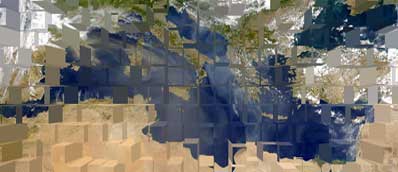
Funded by
European Commission
V Framework Program Energy, Environment and Sustainable Development |
FORECASTING AT THE REGIONAL SCALE AND
MODELLING AT THE SHELF SCALE - WORKPACKAGE 9 |
 |
|||
|
|||
|
|||

|
Models Four regional and ten shelf models will be implemented on the basis of the experience already accumulated in MFSPP. The regional models will obtain their boundary conditions (asynchronously nested) from the MFSTEP OGCM (covering the whole Mediterranean) and provide boundary conditions to the shelf models. The four regional models cover the Northwestern Mediterranean, the Sicily Channel area, the Adriatic Sea and the Aegean-Levantine area (so-called ALERMO area). The shelf models cover areas in the Gulf of Lions, Catalan Sea (two shelf models), Malta shelf area, Northern Adriatic, Northern Aegean, Cretan Sea, Cyprus, Southern Turkish coast and Eastern Levantine shelf area. (see adjacent figure). All regional models will have a grid size of approximately 3.5 Km (1/30 deg) while the nominal grid size for shelf models is 1.5 Km. Initialization The model initialization problem is of central importance for a short-range near real time forecast system. A proper initialization procedure produces balanced initial conditions that do not excite inertia-gravity oscillations in model integration, which contaminate the forecasting result. Among different approaches to treat the initialization problem (damping time integration procedures, adjoint model) regional models will use the Variational Initialization technique developed and disseminated in WP7. Air-Sea Physics In addition, the model forecast skill depends crucially on the quality and the way that vertical boundary conditions at the surface are specified. In model simulations, surface fluxes are computed in one of three ways: i) using prescribed momentum and heat/freshwater flux fields (Korres, 2001) , ii) using proper bulk formulae and high frequency atmospheric surface fields in a so called one-way air-sea interaction scheme (Rosati and Miyakoda, 1988, Pinardi et al., 1997, Castellari et al., 1998) and iii) using turbulence-based formulations (Fairall et al., 1996). The strong disadvantage of using prescribed flux fields is the elimination of any feedback mechanism between the atmosphere and ocean while the advantage apart from being computationally inexpensive is the assurance of accurate (but not necessarily realistic) forcing for the hydrodynamic model. The second and third methods on the other hand, have been extensively used in coupled ocean-atmosphere studies, in ocean forecast systems and have been tested (the second one) in the MFSPP OGCM. The strategy to be followed within WP9 as far as the atmosphere-ocean asynchronous coupling is concerned is (ii). Coupling A very important methodological development of this workpackage will be the asynchronous coupling of the MFSTEP-OGCM with the regional and shelf models. Regional forecasts will be done once a week initialized from the MFSTEP-OGCM fields released at day J+1 (J denotes the weekly MFSTEP-OGCM nowcast). The regional forecasts will be extended for three-five days with high resolution atmospheric fields, released by WP10. Thus regional forecasts will start nominally at J+1. Open boundary conditions updates for these runs will be provided by the MFSTEP-OGCM forecast fields daily updates for that period. Finally, regional model forecasts will be released at day J+2, i.e., with one day delay with respect to their real start of forecast. |
| |